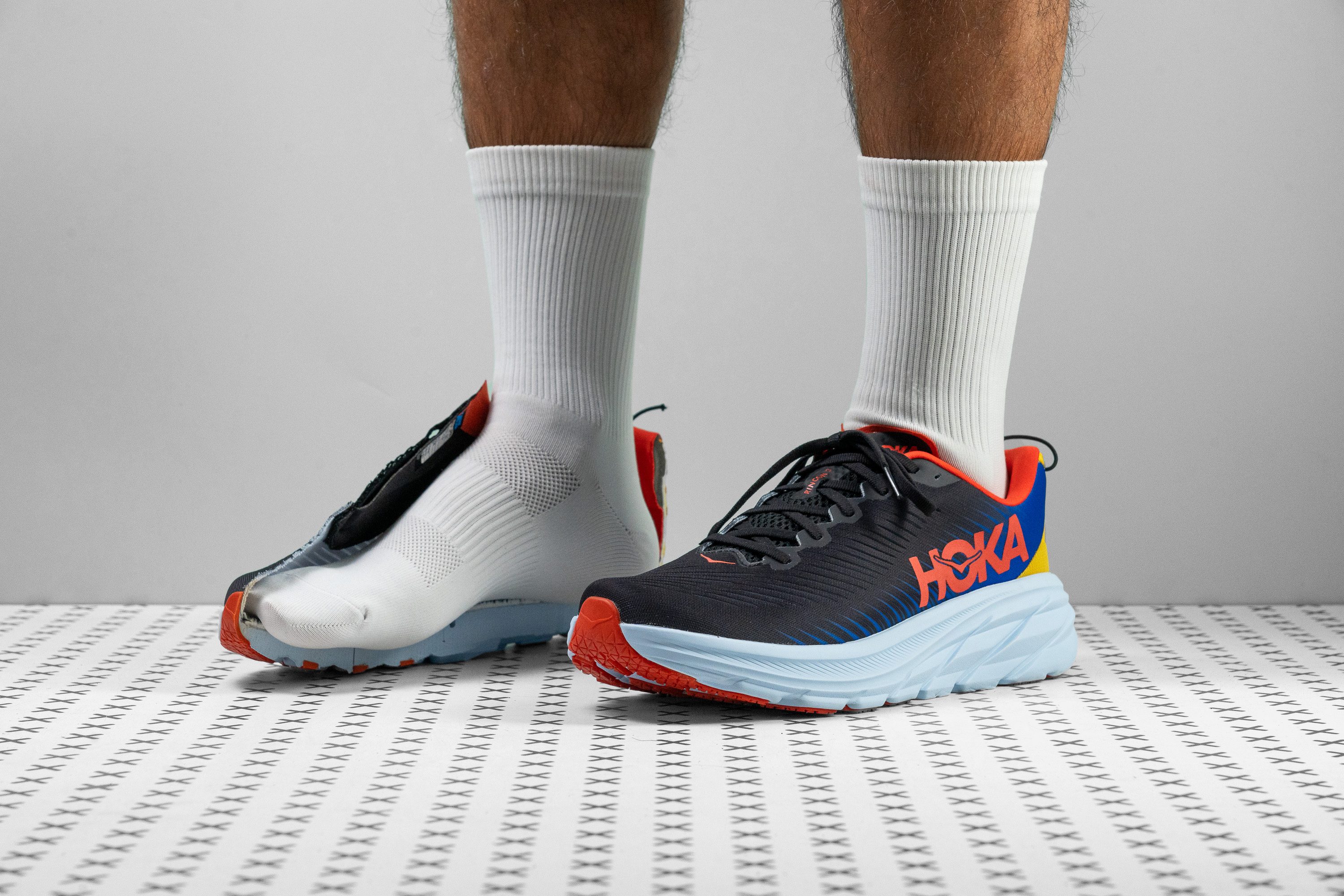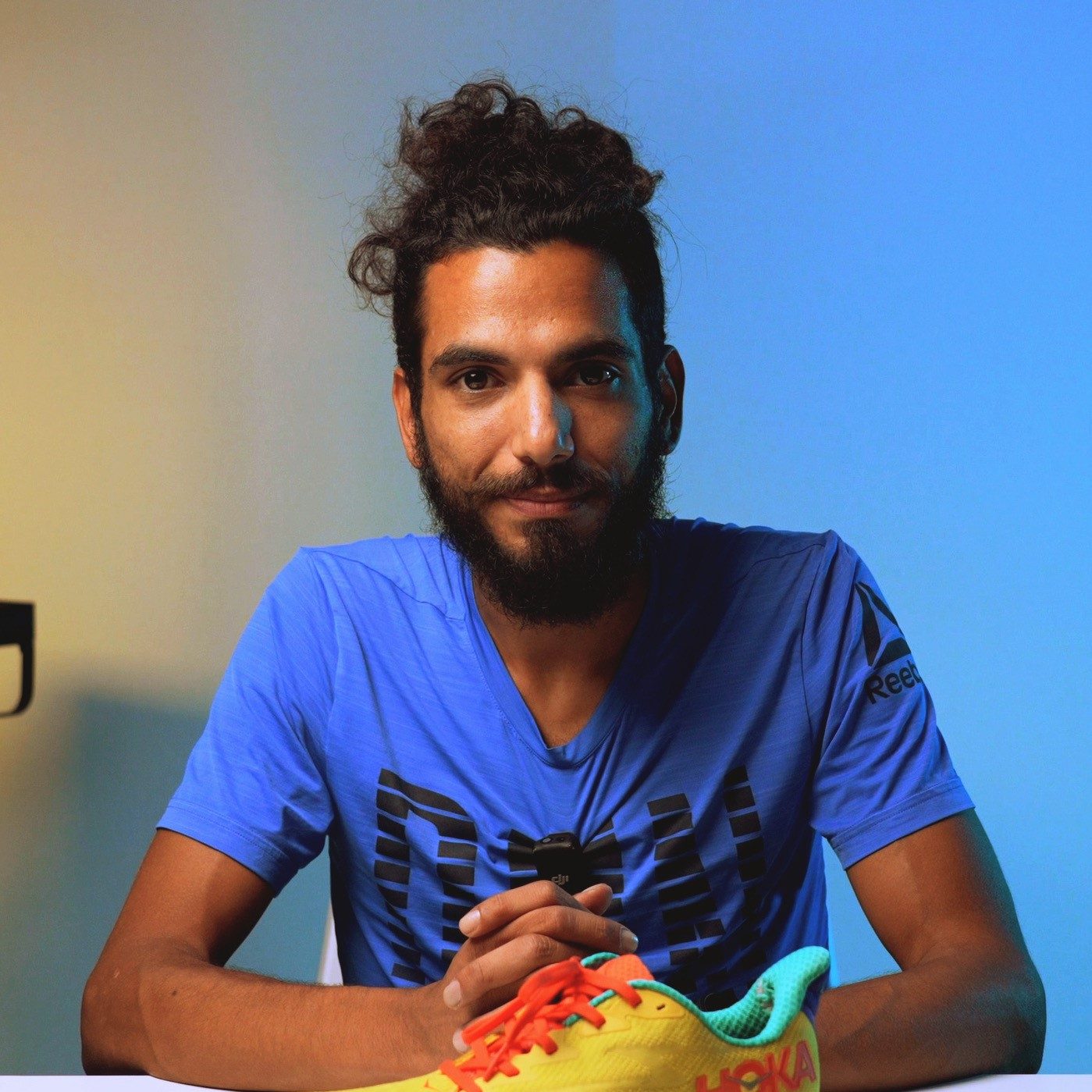Our verdict
Pros
- Light as a feather
- Smooth and responsive ride
- Suitable for long distances
- Performs consistently in the cold
- Extremely breathable
- High-quality, durable upper
Cons
- A blister magnet for wide feet
- Thin tongue doesn’t stay in place
- Lace bites
- Low energy return
Audience verdict
- Top 30% in shoes for gym and running
Comparison
The most similar running shoes compared
+ + Add a shoe | |||||
|---|---|---|---|---|---|
| Audience score | 87 Great! | 92 Superb! | 80 Good! | 87 Great! | |
| Price | $125 | $125 | $125 | $125 | |
| Pace | Daily runningTempo | Daily running | Daily running | Daily running | |
| Shock absorption | Moderate | High | High | Moderate | |
| Energy return | Low | Moderate | Moderate | Low | |
| Traction | Moderate | Moderate | High | Moderate | |
| Arch support | Neutral | Neutral | Stability | Neutral | |
| Weight lab Weight brand | 7.3 oz / 208g 7.4 oz / 210g | 10.1 oz / 285g 9.7 oz / 275g | 8.1 oz / 231g 8 oz / 228g | 8.2 oz / 232g 8.5 oz / 241g | |
| Lightweight | ✓ | ✗ | ✓ | ✓ | |
| Drop lab Drop brand | 6.2 mm 5.0 mm | 6.5 mm 6.0 mm | 9.4 mm 5.0 mm | 6.4 mm 6.0 mm | |
| Strike pattern | Mid/forefoot | Mid/forefoot | HeelMid/forefoot | Mid/forefoot | |
| Size | True to size | True to size | Slightly small | True to size | |
| Midsole softness | Balanced | Soft | Soft | Balanced | |
| Difference in midsole softness in cold | Small | Normal | Big | Big | |
| Toebox durability | Decent | Decent | Bad | Good | |
| Heel padding durability | Good | Bad | Decent | Decent | |
| Outsole durability | Good | Good | Bad | - | |
| Breathability | Breathable | Moderate | Breathable | Moderate | |
| Width / fit | Narrow | Narrow | Narrow | Narrow | |
| Toebox width | Medium | Medium | Narrow | Narrow | |
| Stiffness | Moderate | Moderate | Moderate | Moderate | |
| Torsional rigidity | Stiff | Stiff | Stiff | Moderate | |
| Heel counter stiffness | Flexible | Moderate | Stiff | Flexible | |
| Rocker | ✗ | ✓ | ✓ | ✗ | |
| Heel lab Heel brand | 31.8 mm 29.0 mm | 34.1 mm 38.0 mm | 36.0 mm 33.0 mm | 30.4 mm 26.0 mm | |
| Forefoot lab Forefoot brand | 25.6 mm 24.0 mm | 27.6 mm 32.0 mm | 26.6 mm 28.0 mm | 24.0 mm 20.0 mm | |
| Widths available | NormalWide | Normal | NormalWide | NormalWide | |
| Orthotic friendly | ✓ | ✓ | ✓ | ✓ | |
| Season | SummerAll seasons | All seasons | SummerAll seasons | All seasons | |
| Removable insole | ✓ | ✓ | ✓ | ✓ | |
| Ranking | #316 Top 48% | #7 Top 2% | #304 Bottom 18% | #157 Top 43% | |
| Popularity | #254 Top 39% | #270 Bottom 27% | #87 Top 24% | #89 Top 24% |
Who should buy
We recommend the Hoka Rincon 3 as a great option for:
- Runners of all skill levels looking for a versatile and lightweight daily trainer
- Speed freaks looking to challenge their PRs or train for a race
- Fans of long distances who need a responsive and well-cushioned road shoe
- Casual runners looking for a shoe that can convert anything from jogs to sprints to walks
- Cold-climate runners who want a shoe that performs consistently no matter the weather
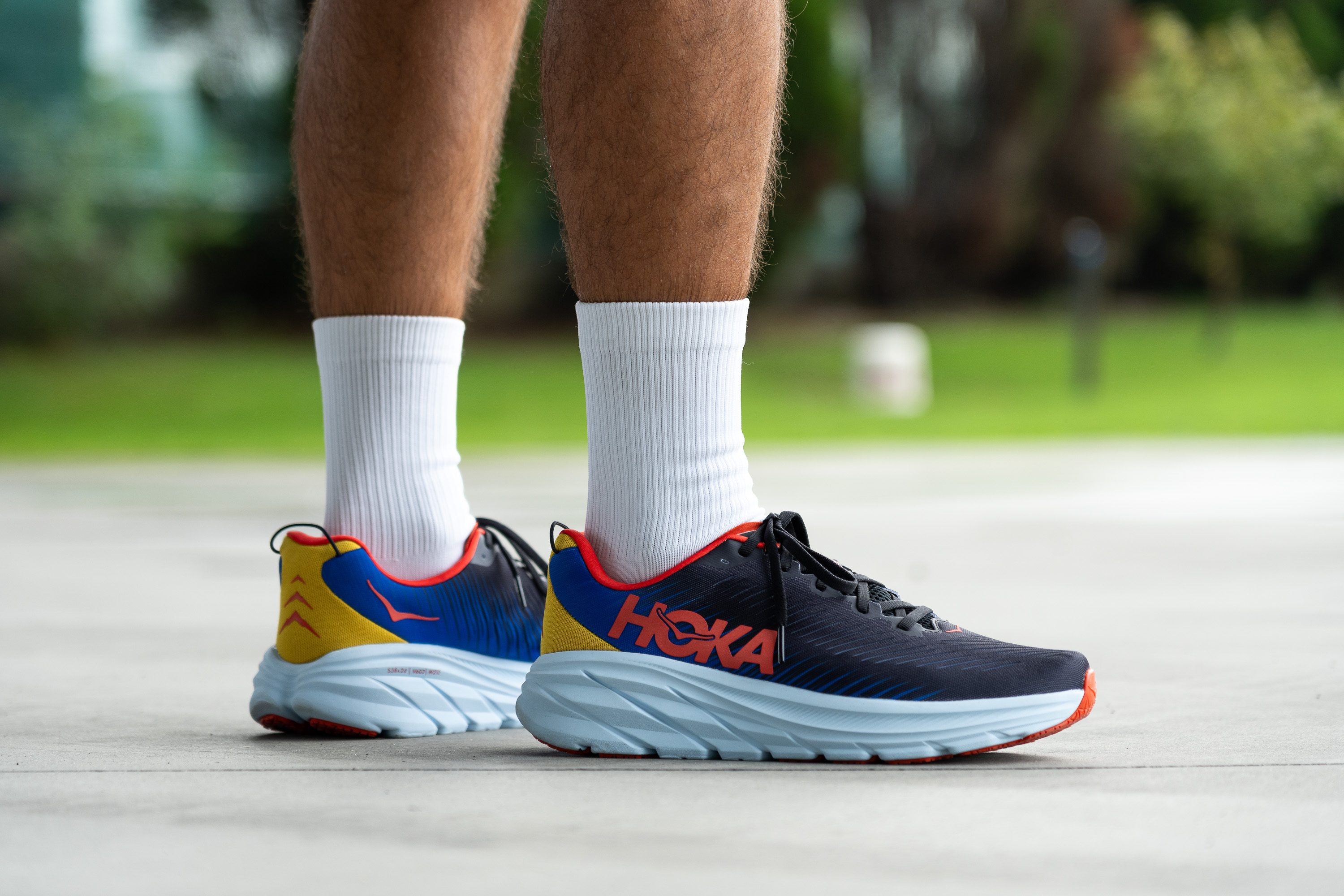
Who should NOT buy
The Rincon 3’s midsole doesn’t feel quite as plush underfoot as it looks, so runners who prefer a speedy yet supple ride should consider the Hoka Mach X or the ASICS Novablast 3 instead.
Boasting a rather robust stack means that we didn’t get much ground feel during our test runs in the Rincon 3. For runners who prefer being more in touch with the road beneath, we recommend the similarly lightweight Brooks Hyperion as an alternative.
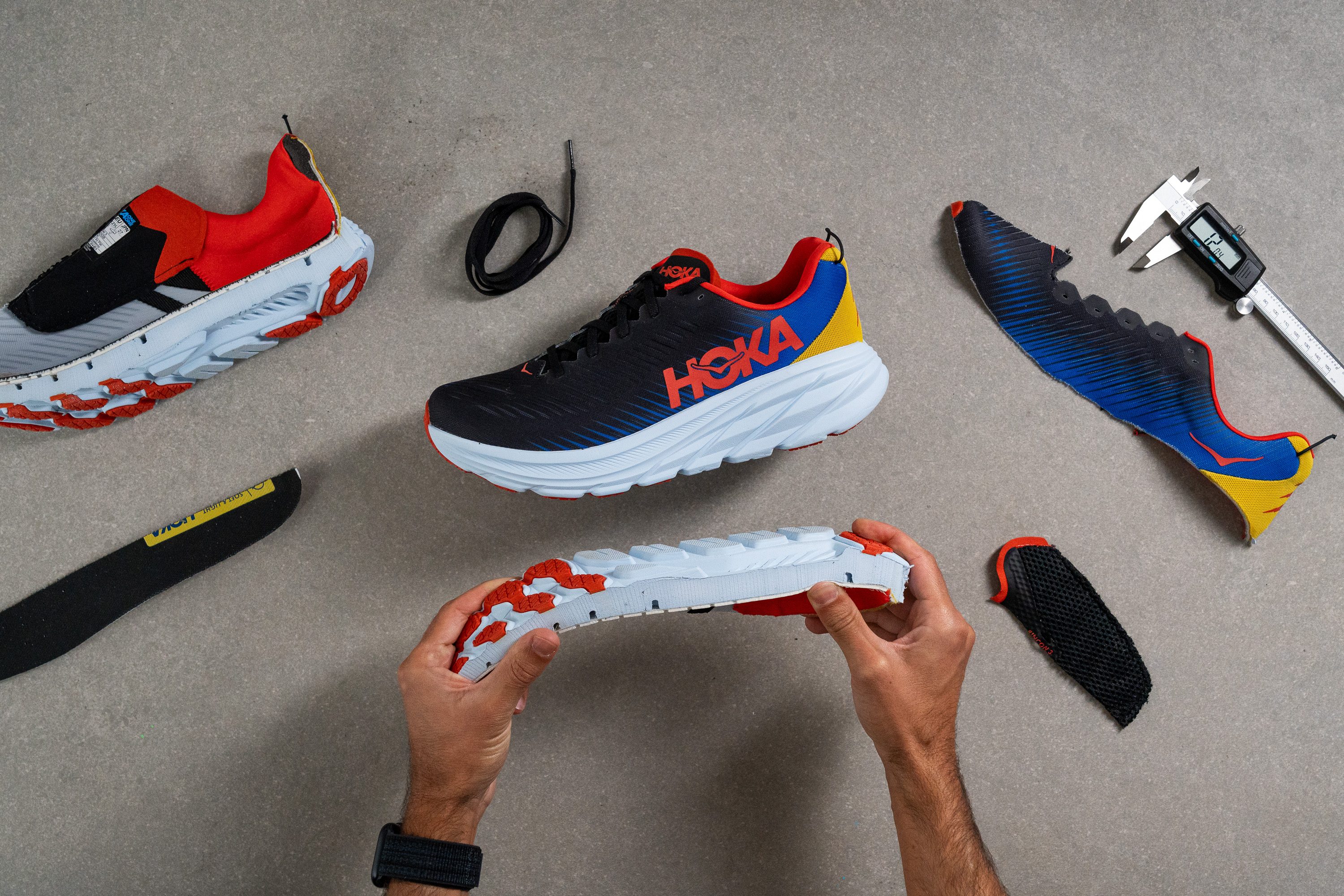
The toebox isn’t exceptionally narrow, but the stiffness of the jacquard mesh upper means that it doesn’t stretch very much. This combination means that this shoe will definitely be a blister magnet for those with wide feet. It will likely even pose a challenge to those with normal-width feet towards the end of long-distance runs when the feet tend to swell up. Luckily the Rincon 3 comes in a wide option or, alternatively, we recommend the Brooks Launch 10 as a roomier option that can also go the distance.
Cushioning
Shock absorption
The Rincon aims to suit as many runners as possible, which means average shock absorption paired with a moderately thick midsole. That’s exactly what it delivers: 121 SA in the heel and 103 SA in the forefoot.
It’s not the shoe you’d choose for a 20-mile long run, but it works well for short to medium-distance efforts.

| Hoka Rincon 3 | 121 SA |
| Average | 129 SA |
Energy return
We tested energy return as well and found it lower than expected. It didn’t even reach the lab average, landing at just 47.0% in the heel. Let’s see if version 4 brings some improvement.
| Hoka Rincon 3 | 47.0% |
| Average | 58.5% |
Heel stack
Using our caliper, we measured the Rincon 3’s stack to be 31.8 mm thick at the heel. This marks a discrepancy with Hoka’s officially stated 29 mm. While this isn’t quite as thick as our current lab average, it still provides heel stickers with plenty of protective foam underfoot to ensure well-cushioned landings over any distance.
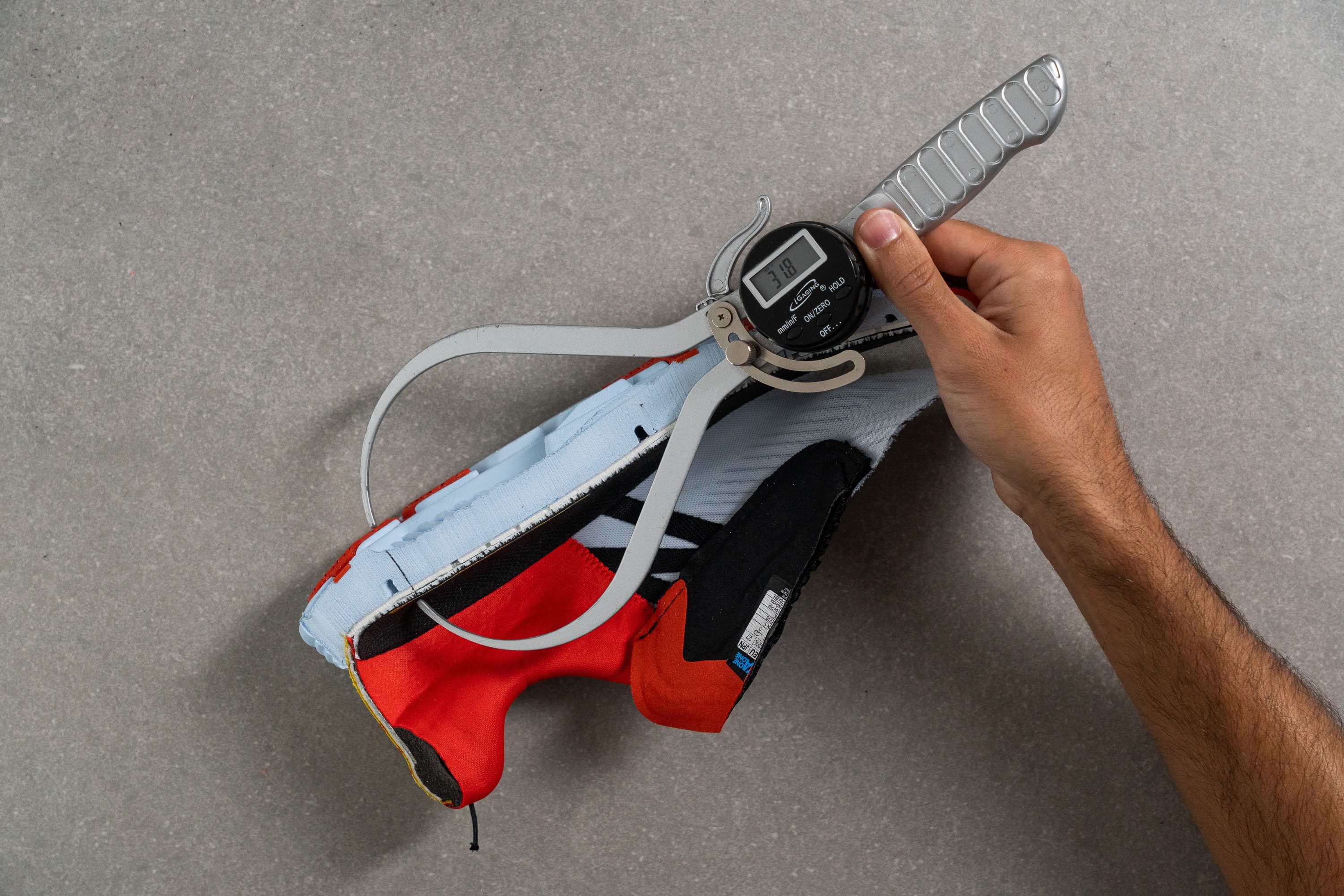
| Hoka Rincon 3 | 31.8 mm |
| Average | 34.8 mm |
Forefoot stack
The forefoot stack measurement of 24 mm provided by Hoka proves to be only slightly more accurate, with our caliper turning up a stack height of 25.6 mm. This is higher than our current lab average and means that forefoot strikers will also enjoy an ample amount of foam underfoot to dampen their landings.

| Hoka Rincon 3 | 25.6 mm |
| Average | 26.2 mm |
Drop
While advertised as sporting a 5 mm offset, the difference in our accurate stack measurements leaves the shoe with an actual drop height of 6.6 mm. However, this inaccuracy is quite small (compared to others we’ve found) and still classifies the Rincon 3 as a mid-drop shoe, so only highly-attuned runners will notice this discrepancy. This heel drop is quite versatile and will suit the needs of a wide variety of runners whether heel or midfoot/forefoot strikers.

| Hoka Rincon 3 | 6.2 mm |
| Average | 8.6 mm |
Midsole softness
The Rincon 3’s midsole gives us a durometer reading of 23.4 HA, which is right on par with our current lab average.
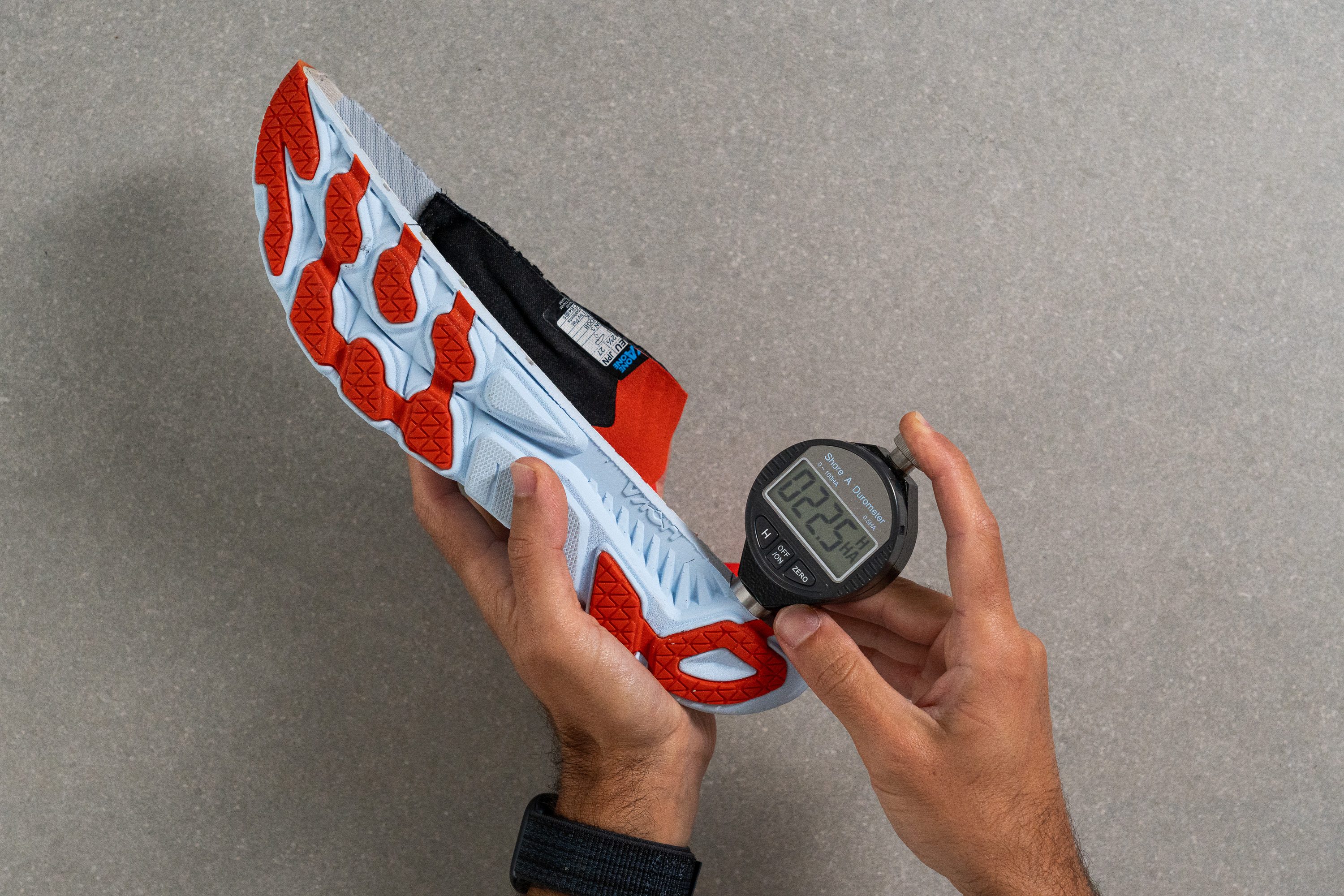
While it does initially feel a little firmer than that underfoot (possibly as a result of the hard rubber outsole) the shoe’s cushioning does a great job of softening the impact of our landings during our test runs.
While the Rincon 3’s midsole feels reactive, it doesn’t provide the energetic bounce that characterizes the foams found in most modern tempo trainers. Rather, its curved meta-rocker design is the Rincon 3’s subtle ace in the hole.

By having the midsole curve upwards significantly so far up toward the toes, the shoe facilitates quick and smooth transitions onto our forefoot. This helps to improve our cadence and encourages us to run faster
| Hoka Rincon 3 | 23.4 HA |
| Average | 20.4 HA |
Size and fit
Size
Hoka Rincon 3 fits true to size (215 votes).
Toebox width - widest part
Using our caliper, we measured the Rincon 3’s toebox to be 97.2 mm wide at its widest point, which is right on par with our current lab average. While not ideal for wide-footed runners, this should suit runners with narrow to normal-width feet just fine. However, as briefly mentioned earlier, the unforgiving jacquard mesh means that the foot doesn’t have much room to go in the event of swelling, making hotspots during long-distance runs a distinct likelihood for most runners.
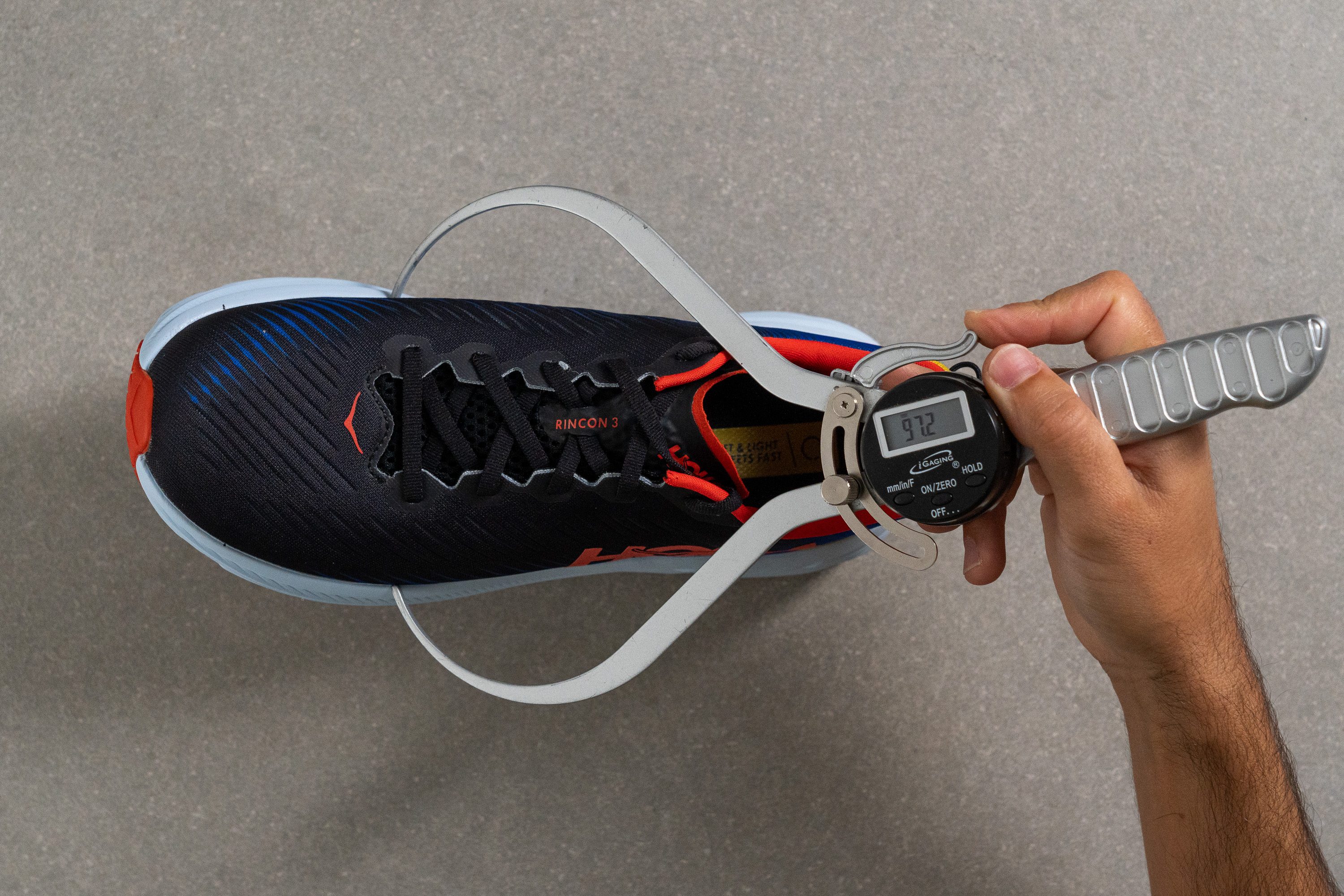
This test follows an older methodology, which is why you don't see recently tested shoes in the chart. Results from different methodologies can not be compared.
| Hoka Rincon 3 | 97.2 mm |
| Average | 98.5 mm |
Toebox width - big toe
Moving up to the area around the big toe, we found that the Rincon 3 doesn’t taper as much as the average road shoe. At 78.4 mm wide according to our caliper, the toebox is slightly roomier than average at that part of the shoe. This means that we had enough space for our toes to splay out comfortably during our test runs.

This test follows an older methodology, which is why you don't see recently tested shoes in the chart. Results from different methodologies can not be compared.
| Hoka Rincon 3 | 78.4 mm |
| Average | 78.4 mm |
Traction / Grip
Traction test
If you're looking for a grippy running shoe, the Rincon 3 will fall short. We measured a modest 0.32 in our grip test, placing it in the lower range—adequate for dry conditions, but noticeably less secure when roads get slick.
| Hoka Rincon 3 | 0.32 |
| Average | 0.48 |
Outsole design
The Hoka Rincon 3 features minor rubber coverage with a segmented layout. Durable rubber pods are strategically placed at the heel and forefoot, while the midfoot is exposed although it features a thin reinforcement. These bright red sections sit atop exposed EVA foam that makes up most of the outsole surface.
Multiple deep flex grooves span across the midfoot and forefoot. The outsole also incorporates geometric cutouts and a wide central channel to enhance flexibility.
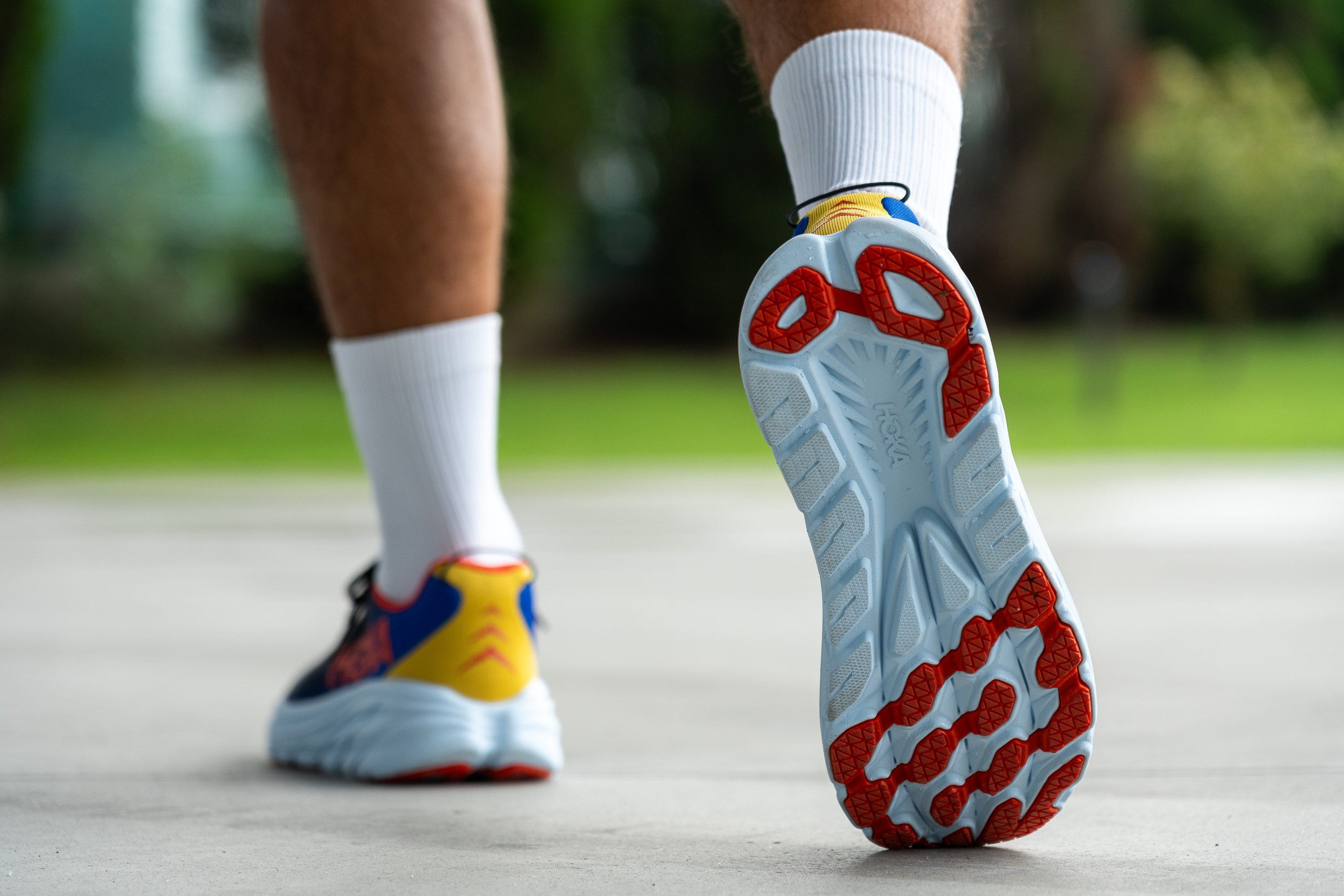
Flexibility / Stiffness
To assess the shoe’s flexibility, we secured the Rincon 3 to our machine and measured the amount of force needed to bend it 30 degrees. Requiring 13.2N to torque the shoe to the appropriate point makes the Rincon 3 similar to the average road shoe.
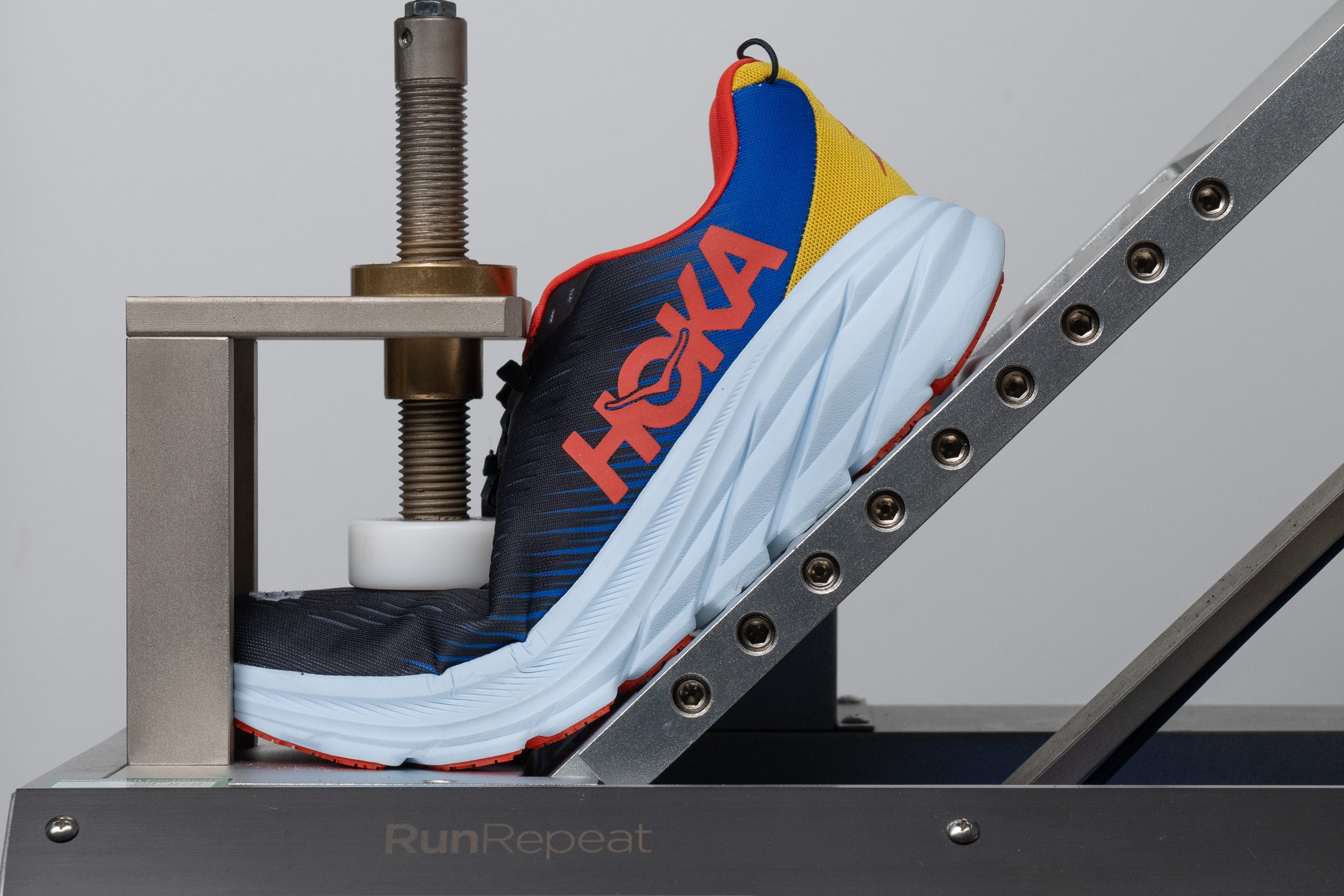
| Hoka Rincon 3 | 13.2N |
| Average | 15.3N |
Stiffness in cold (%)
We repeated our flex test after leaving the Rincon 3 in the freezer for twenty minutes and found that 23.2N of force was required to bend the cold shoe to the same point. This is still remarkably flexible compared to the average road shoe under similar conditions. In fact, it’s more flexible than average at room temperature too! As such, the Rincon 3 should feel just as easy on the foot during frosty and difficult winter sessions as it does in the summertime when living is easy.
Becoming only 21.5% stiffer in the cold makes the Rincon 3 much more consistent than the average road shoe between warm and cold. In practical terms, this means that the shoe should deliver a ride that feels comfortable and smooth all year round.
| Hoka Rincon 3 | 22% |
| Average | 33% |
Weight
For a shoe with a healthy stack, it’s quite off-putting how light the Rincon 3 feels when picking it up for the first time. At only 7.35 oz (208g) according to our scale, the Rincon 3 isn’t just lighter than the average road shoe, it rivals many racing shoes on the market! This gives the shoe a barely-there sensation underfoot that makes it extremely conducive to torching the tarmac for tempo sessions.
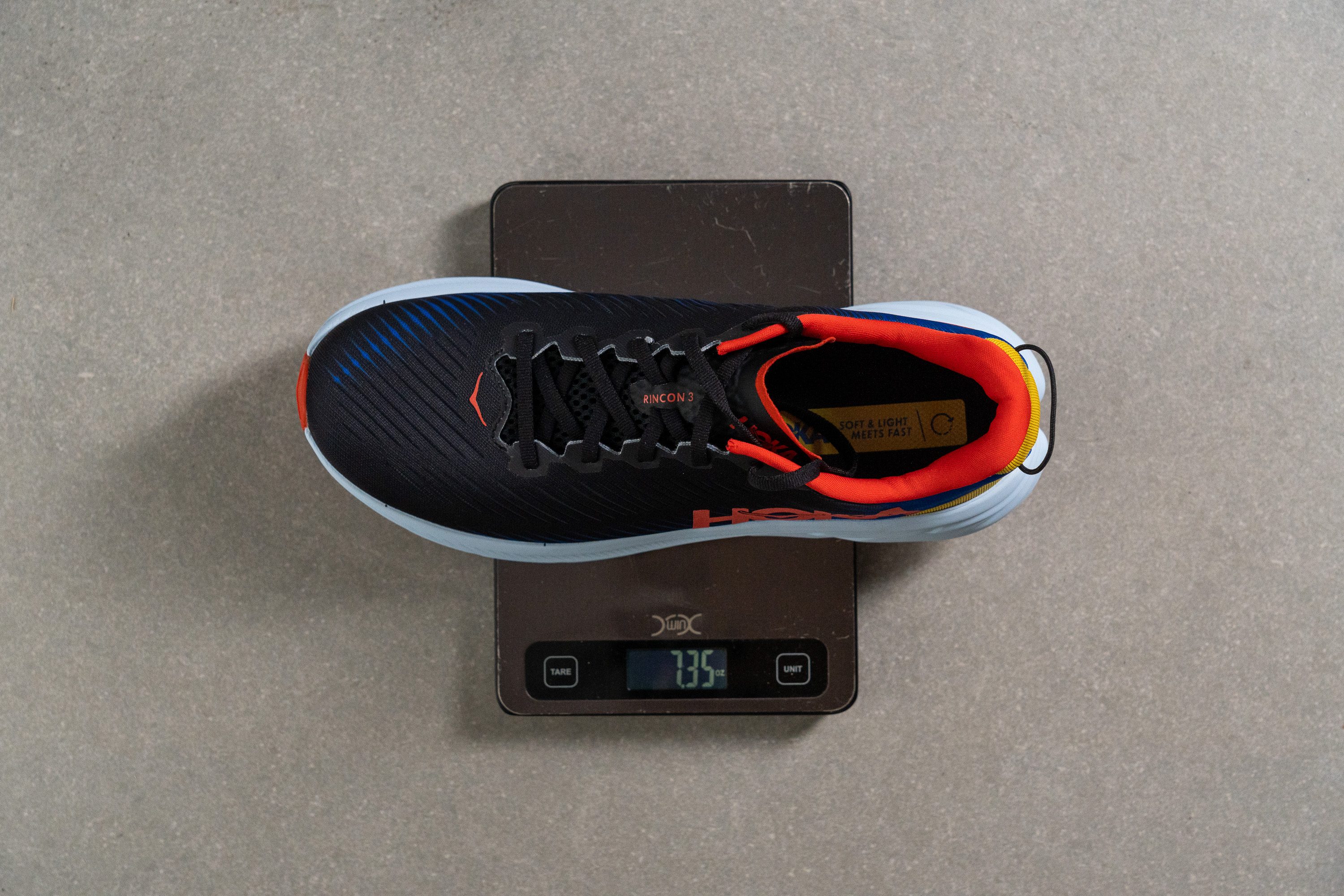
| Hoka Rincon 3 | 7.3 oz (208g) |
| Average | 9.3 oz (264g) |
Breathability
The Rincon 3’s upper looks worryingly solid and smooth, with almost no visible perforations to speak of. As such, we tempered our expectations as we started the smoke test. To our great surprise, the Rincon 3 quickly becomes a chimney; churning out smoke in a constant thick plume throughout the shoe. As a result, we give the shoe a well-earned perfect 5 out of 5 for breathability, making it a great training partner for runs on hot summer days.
Inspecting a backlit cross-section of the Rincon 3’s upper, it’s incredible to see how translucent the toebox is compared to the rest of the shoe. This is especially impressive considering how uniform the material looks from a distance.
Our breathtaking microscope shot reveals that the upper is made of two layers of mesh. The dark layer on top consists of beautifully woven, evenly-spaced braids with lots of space for airflow. This layer features almost imperceptible streaks that open up to an even airier mesh underneath that heat can easily vent through. In hindsight, we shouldn’t have been so shocked by the shoe’s top-notch performance in our previous test.
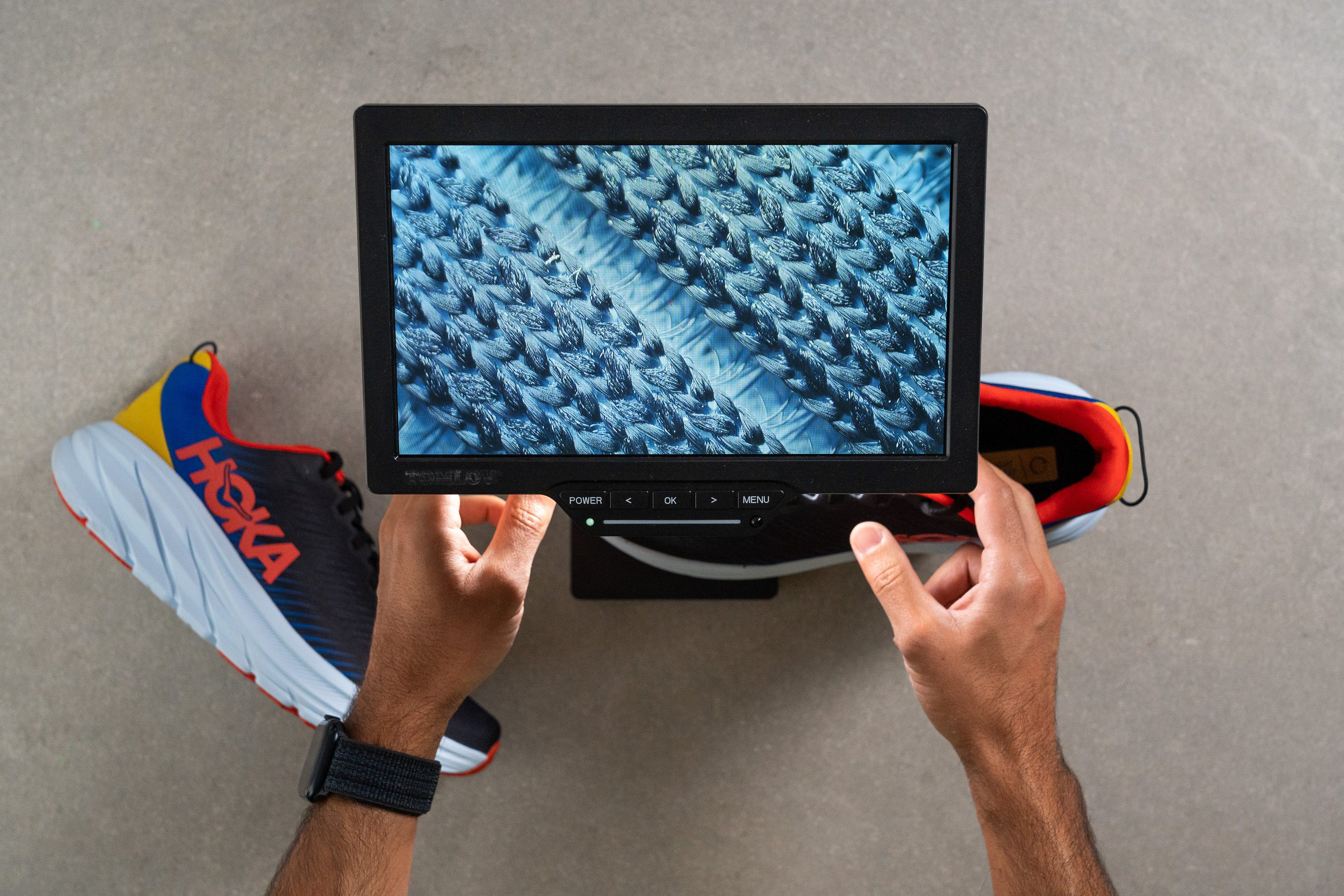
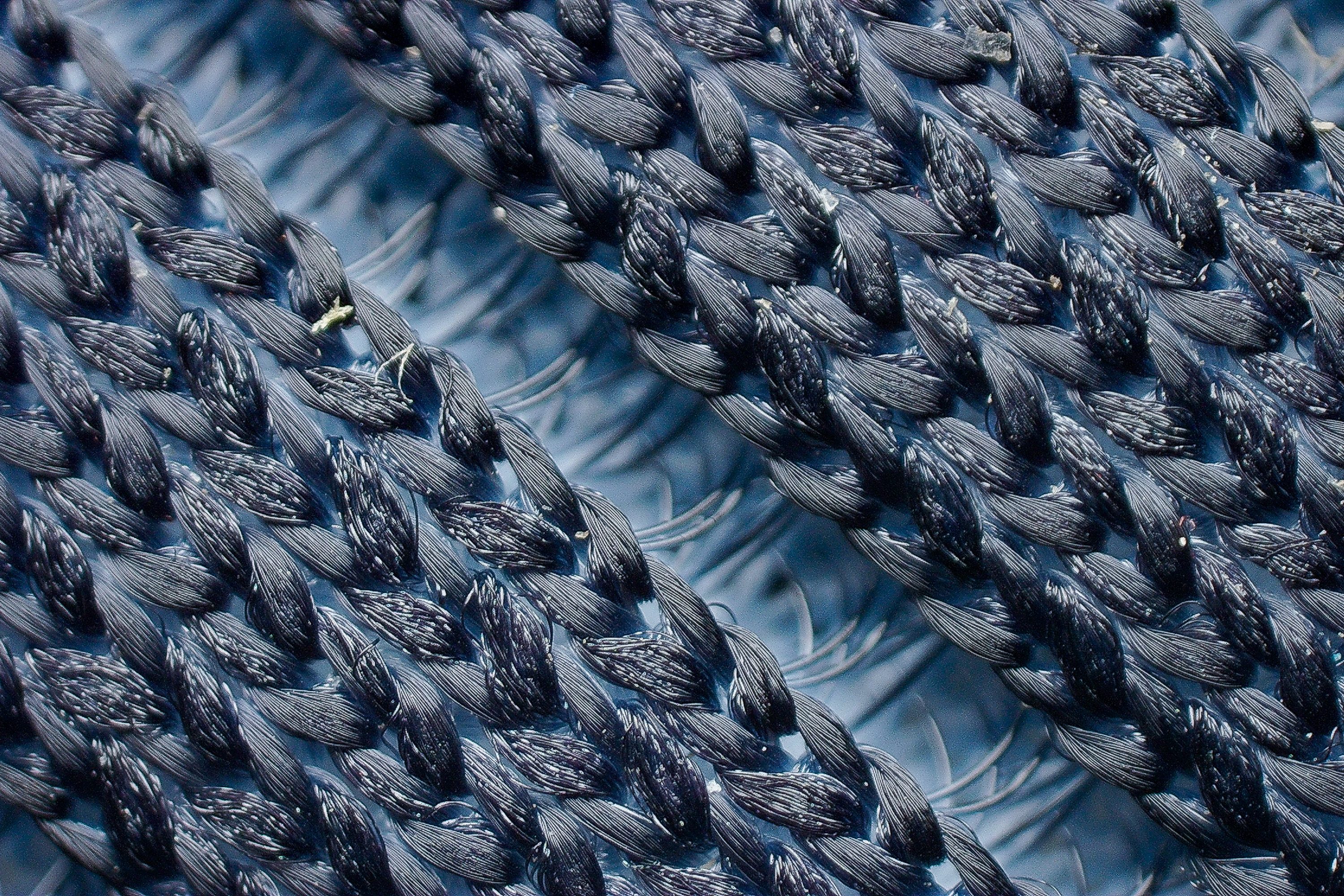
| Hoka Rincon 3 | 5 |
| Average | 3.7 |
Stability
Lateral stability test
The Rincon 3 feels remarkably well-planted when shifting our weight from side to side in the shoe. While it’s not as supportive as dedicated stability shoes, the Rincon 3 should be stable enough for runners with slight overpronation in their stride.
For overpronating runners who do need added stability features, we recommend the ASICS Gel Kayano 30 or the speedy Saucony Tempus as good alternatives.
Torsional rigidity
We could barely get the Rincon 3 to budge as we tried to bend and twist the shoe in our hands. This leads us to give the shoe a maximum score of 5 out of 5 for torsional rigidity, putting the shoe on par with stiff, carbon-plated shoes. This level of rigidity keeps the shoe’s base as level as possible, thus ensuring that we have an extremely stable landing surface during our test runs.
| Hoka Rincon 3 | 5 |
| Average | 3.5 |
Heel counter stiffness
The heel counter, conversely, was rather easy to manipulate as we probed and squeezed on it during our manual assessment. This leads us to give the Rincon 3 a heel counter stiffness score of 2 out of 5. This is a good level for a daily trainer as it comfortably holds the rearfoot in place without putting pressure on our heel or tendons. The generous padding in the well-shaped heel cup also serves to securely hold our foot in place without the heel counter having to be so stiff.
| Hoka Rincon 3 | 2 |
| Average | 2.9 |
Midsole width - forefoot
We measured the Rincon 3’s midsole to be 113.2 mm wide at the forefoot, which is right on par with our current lab average. This means that we had an adequately broad surface to ensure stable landings and toe-offs during our test runs.

| Hoka Rincon 3 | 113.2 mm |
| Average | 114.4 mm |
Midsole width - heel
We found the midsole to be wider than average at the heel, measuring 95.7 mm wide according to our caliper.
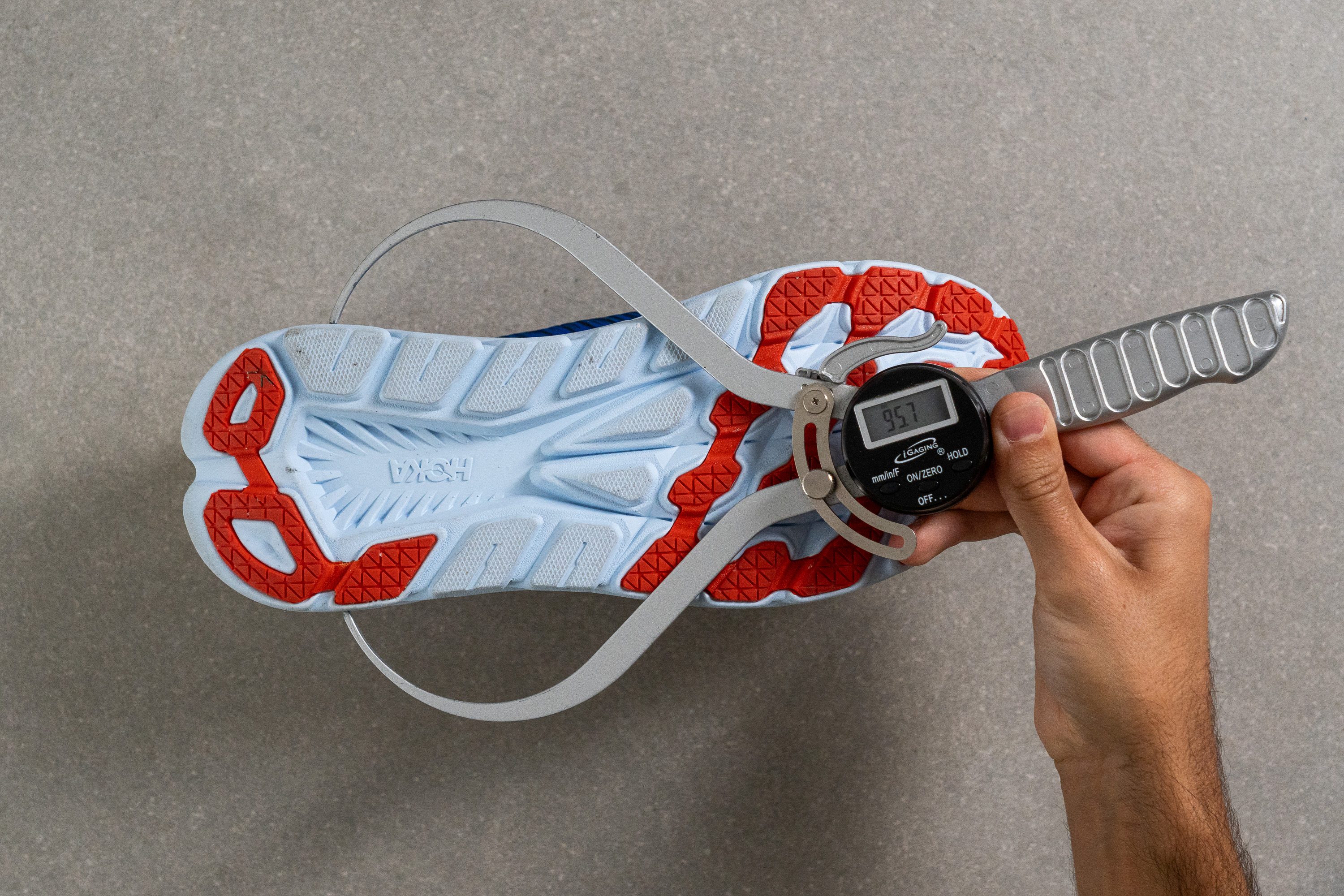
This means that heel strikers have a nice and wide landing surface that should keep them feeling surefooted even when accelerating or taking speedy corners.
| Hoka Rincon 3 | 95.7 mm |
| Average | 90.7 mm |
Durability
Toebox durability
Spinning at 5K RPM, we pressed our Dremel’s grinding element against the Rincon 3’s toebox with 3.2N of force. The tool immediately shreds into the upper mesh and makes confetti out of it. Not a promising sign.
However, upon assessing the damage in the aftermath of the four-second test, we were pleasantly surprised to find that we hadn’t wreaked as much havoc as anticipated. With a flimsy layer of mesh still insulating our toes from the elements, the Rincon 3 marginally outperforms many of the shoes that have contended with this test, earning it a 2 out of 5 for toebox durability.
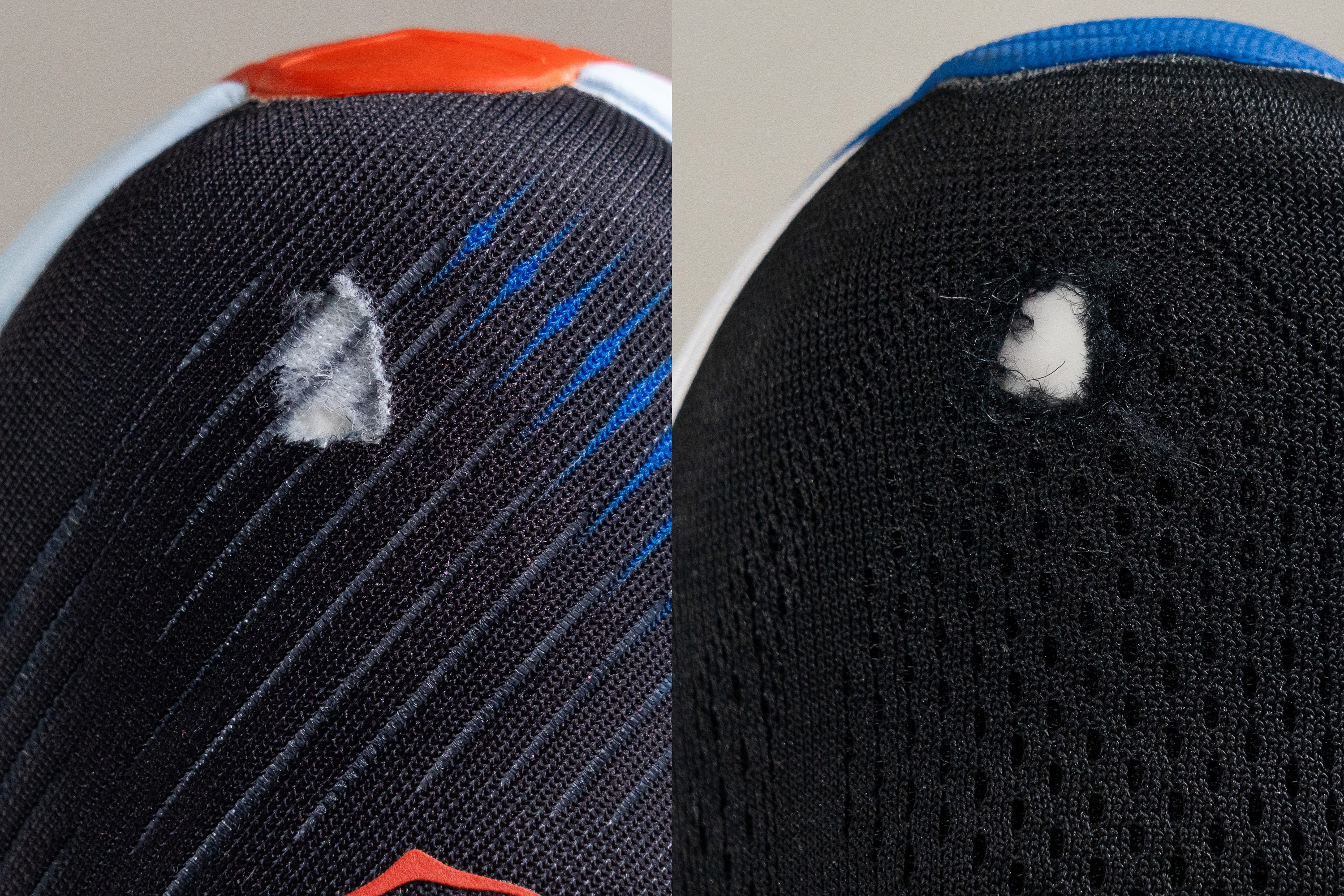
For a truly abysmal performance, check out the ASICS GT 1000 12. It was left with a crater big enough to poke one of our toes through.
| Hoka Rincon 3 | 2 |
| Average | 2.6 |
Heel padding durability
We unleashed our Dremel against the heel counter next and were impressed by how much it resisted our merciless tool. Apart from a little bit of the lining being rolled aside at the onset, the test turned out rather anticlimactic. This above-average performance leads us to give the Rincon 3 a very respectable 4 out of 5 for heel padding durability.
We therefore have no reservations about going for sockless runs in this shoe as it will take a lot more than a little friction to beat this burly lining.

For contrast, have a look at the crater our Dremel left in the Hoka Gaviota 4’s heel counter
| Hoka Rincon 3 | 4 |
| Average | 3.4 |
Outsole hardness
Giving us a durometer reading of 81.8 HC makes the Rincon 3’s outsole only slightly harder than our current lab average. Based on our findings so far in the lab so far, this implies a good balance between traction and durability, the latter of which will be tested next.
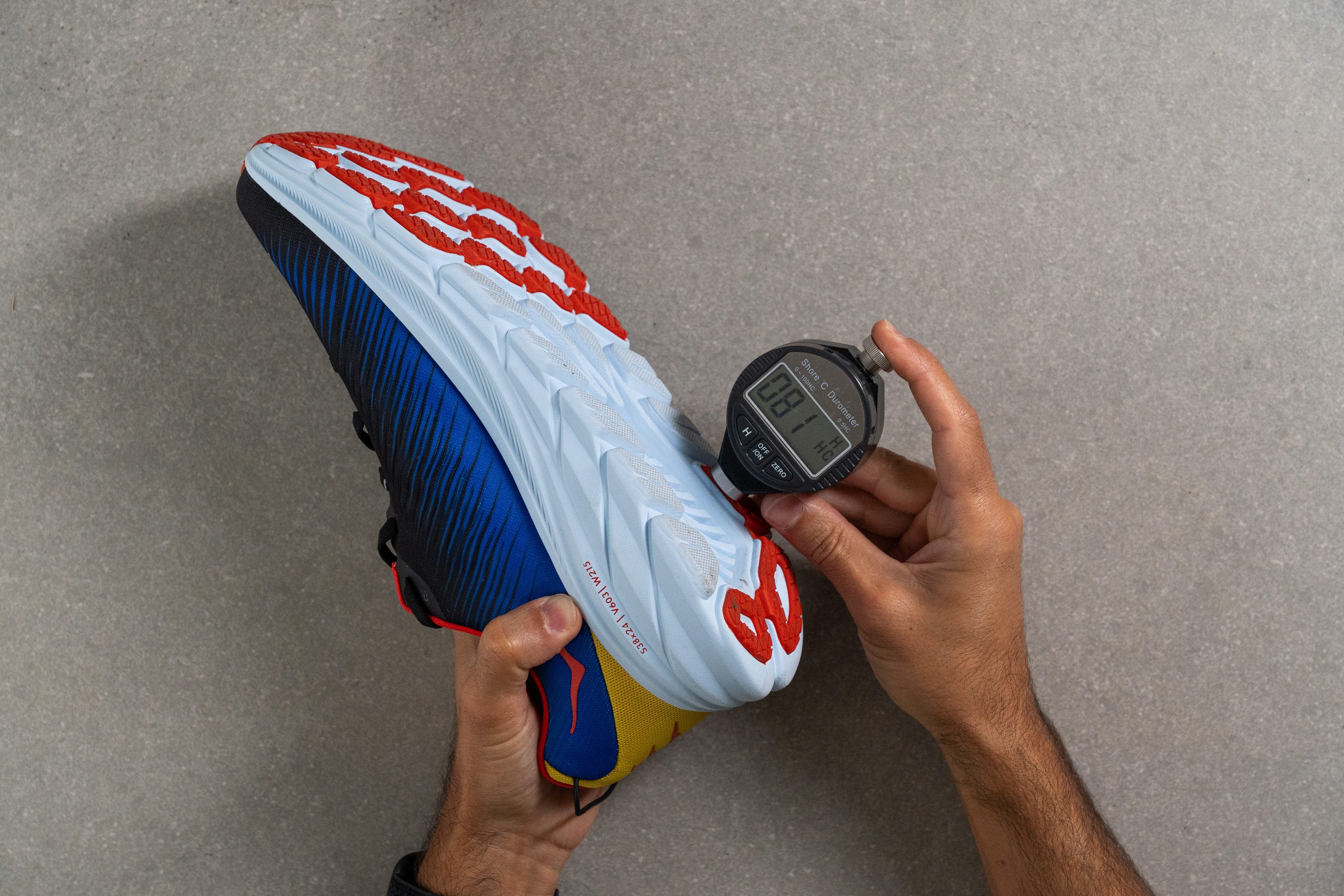
For a more in-depth look at outsole materials and their effects, check out this article that explores the matter using data we’ve uncovered over the course of testing more than a hundred running shoes.
| Hoka Rincon 3 | 81.8 HC |
| Average | 79.2 HC |
Outsole durability
Firing up the Dremel for its third and final appearance, this time spinning at 10K RPM, we applied it to the Rincon 3’s outsole. After a bit of a rocky start, our tool was eventually able to bite into the outsole and begin wreaking havoc, casting aside rather large chunks of rubber by the end of the twenty-second test.
Once the dust had settled, we used a tire gauge to assess the damage and found that we had shorn off 0.84 mm of material from the outsole. This is slightly better than our current lab average, which means that we expect the shoe’s outsole to easily last 400 miles before any major signs of wear and tear.
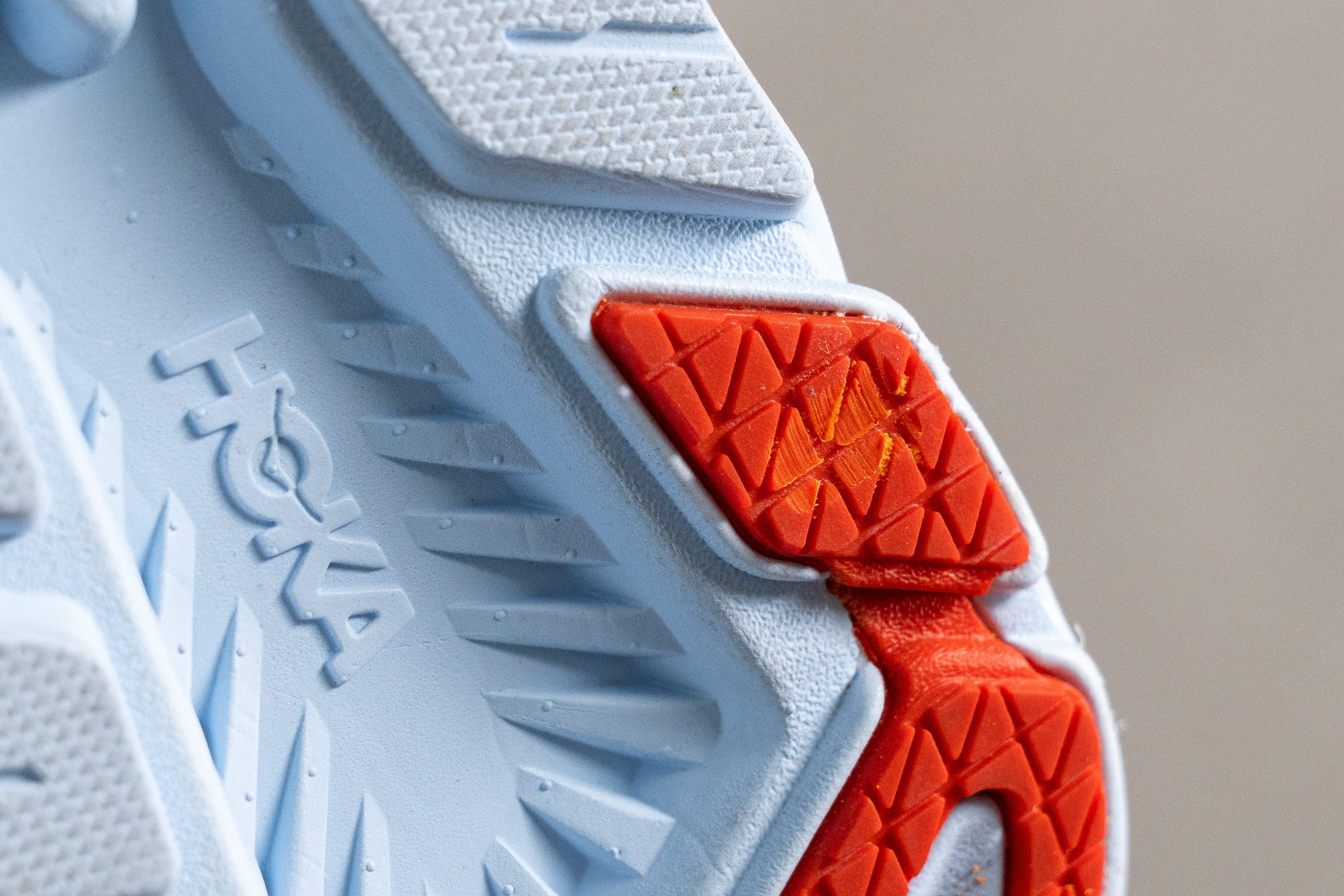
| Hoka Rincon 3 | 0.8 mm |
| Average | 1.1 mm |
Outsole thickness
The Rincon 3’s outsole is right on par with our current average for road shoes at 3.4 mm thick according to our caliper. With the performance of its rubber in our previous test, this doesn’t give us much cause for concern regarding its durability.
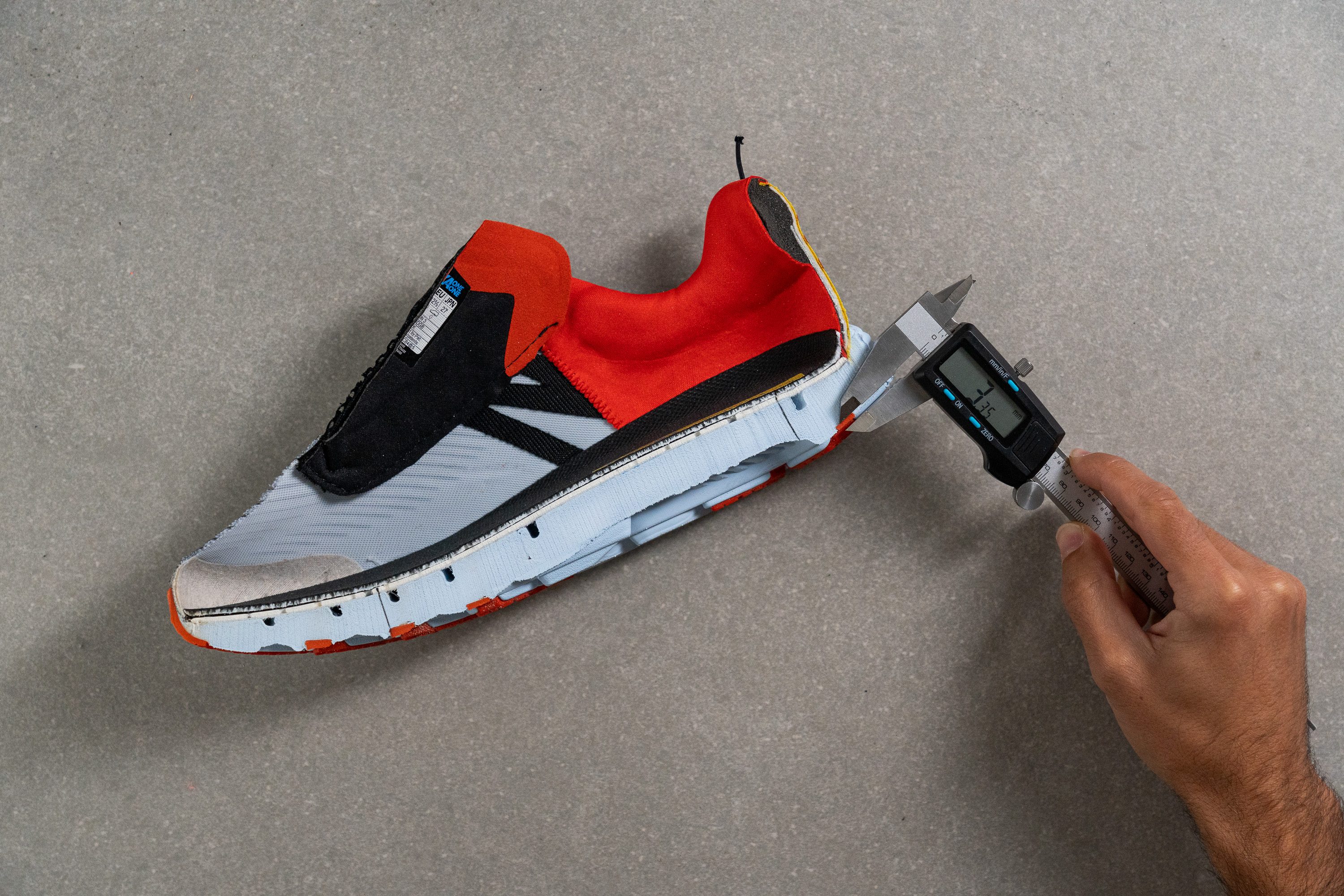
However, the zonal coverage of the outsole means that the Rincon 3 has lots of exposed foam at the bottom of the shoe. So while the outsole should last, we can’t confidently say the same for the integrity of the midsole over time.

| Hoka Rincon 3 | 3.4 mm |
| Average | 3.2 mm |
Misc
Insole thickness
We measured the Rincon 3’s insole at only 2 mm thick which is much more meager than our current lab average. Adding another millimeter or so would have been greatly appreciated as a complement to the midsole cushioning. However, this is easily remedied by replacing the insole with a more substantial one.
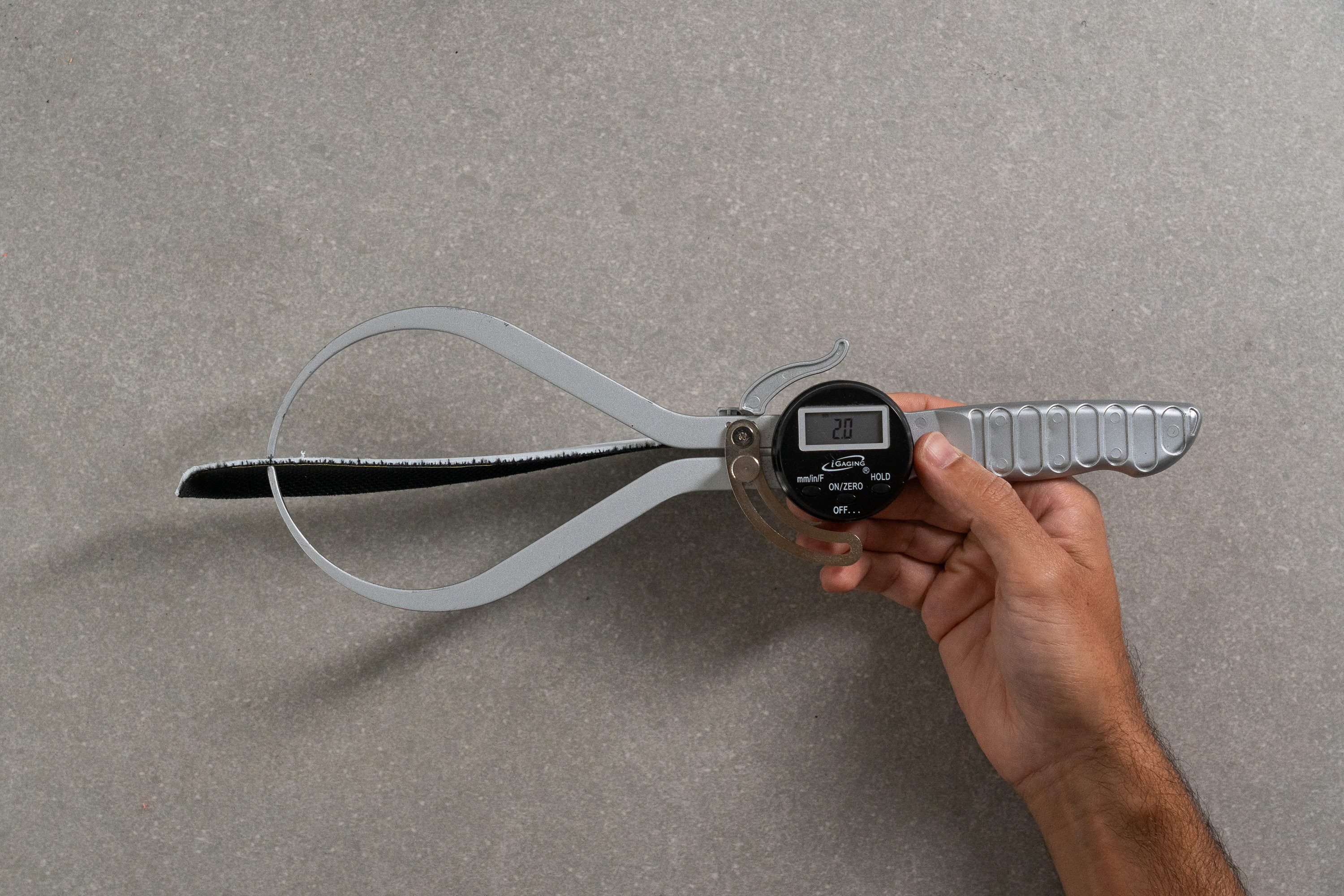
| Hoka Rincon 3 | 2.0 mm |
| Average | 4.5 mm |
Removable insole
The Rincon 3’s insole isn’t glued in so it’s easy to replace with custom orthotics where necessary.

| Hoka Rincon 3 | Yes |
Midsole softness in cold
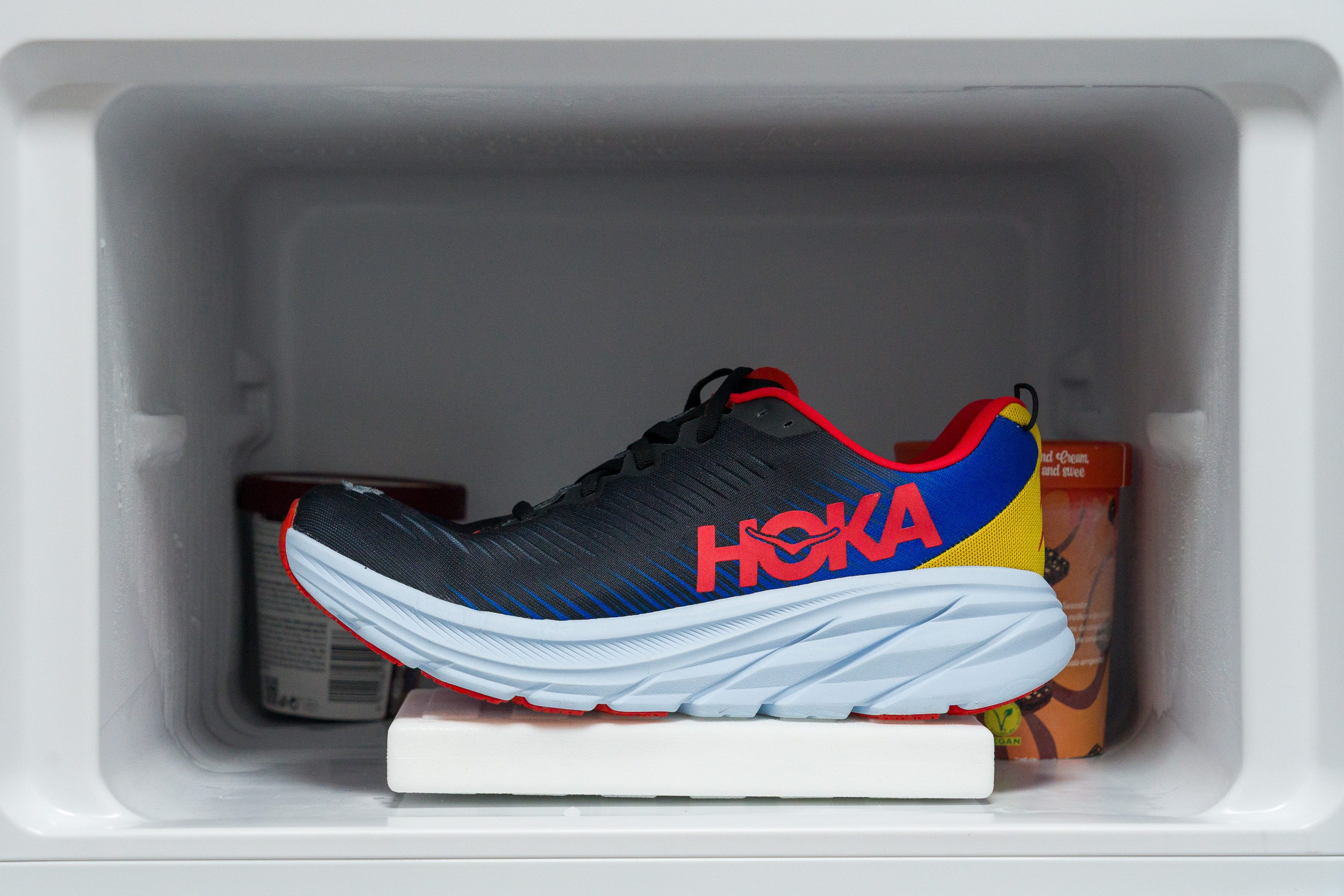
Midsole softness in cold (%)
We placed the Rincon 3 in our freezer to observe the effects of cold conditions on the midsole. After twenty minutes, we pressed our durometer against the midsole once more and this time got a reading of 28.4 HA. This is softer than the average shoe under similar conditions and means that the Rincon 3 should still provide a protective, albeit somewhat firm, level of cushioning even during the most frigid runs.
Becoming only 21.4% firmer in the cold, the Rincon 3’s midsole is more consistent than the average road shoe. As such, we don’t expect the shoe to feel too different underfoot as the seasons change.
| Hoka Rincon 3 | 21% |
| Average | 24% |
Reflective elements
With no reflective elements to be found on the shoe, we recommend that runners looking to burn the midnight oil stick to well-lit routes and/or use additional high-vis gear.

| Hoka Rincon 3 | No |
Tongue padding
At 2.9 mm thick according to our caliper, the Rincon 3’s tongue is much less padded than the average road shoe. This scant padding also doesn’t help with keeping the tongue in place nor protecting us from lace bite during our test runs.
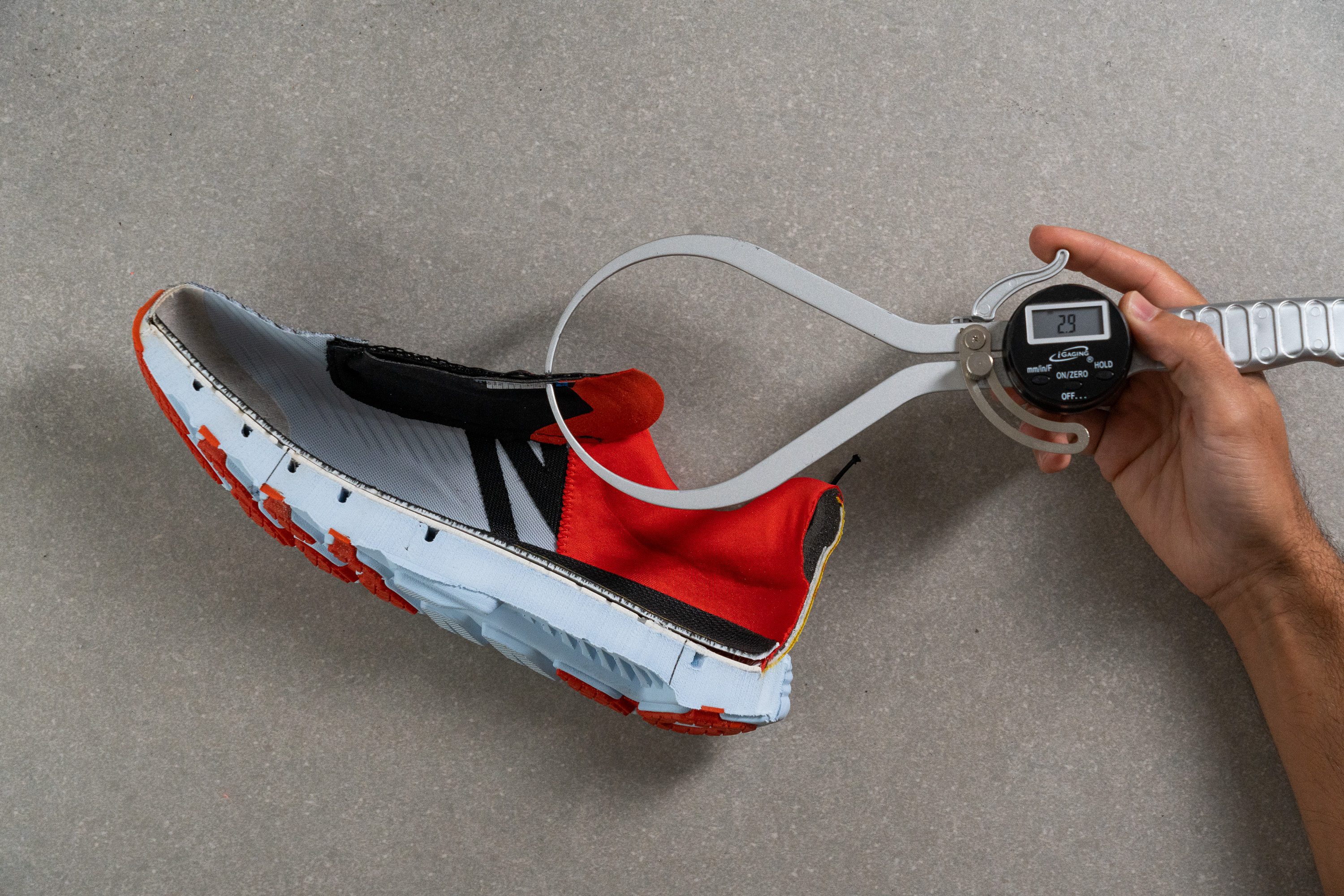
The Brooks Hyperion is another lightweight, speedy daily trainer with a slightly beefier tongue that we recommend to those who prefer more comfort around the instep. It’s semi-gusseted to boot, so slippage wasn’t an issue either.
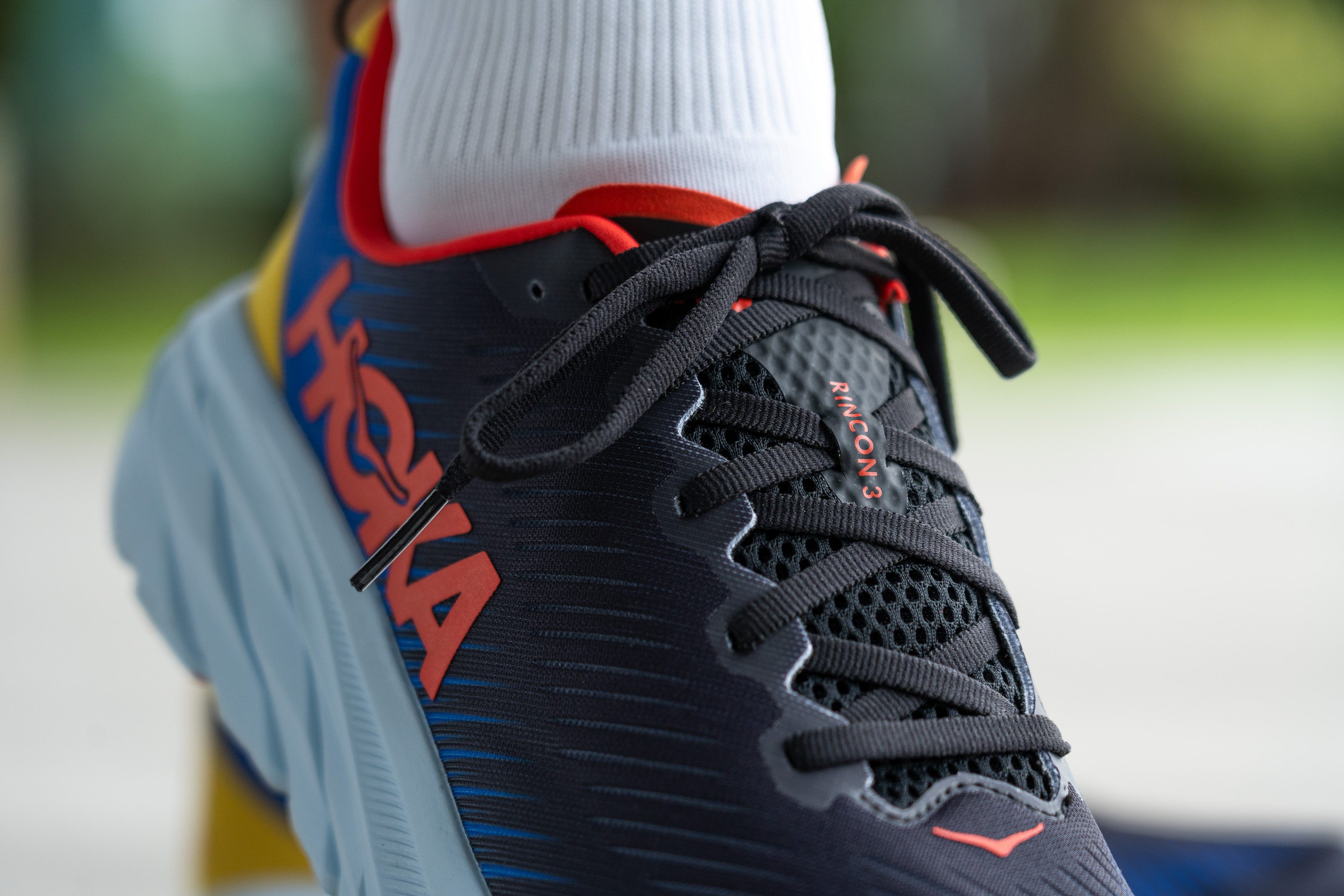
| Hoka Rincon 3 | 2.9 mm |
| Average | 5.8 mm |
Tongue: gusset type
The Rincon 3‘s non-gusseted tongue turns out to be one of the shoe’s key downfalls. It kept sliding over to one side during our test runs sometimes, even slipping below the lace line at times and exposing our instep to lace bite.
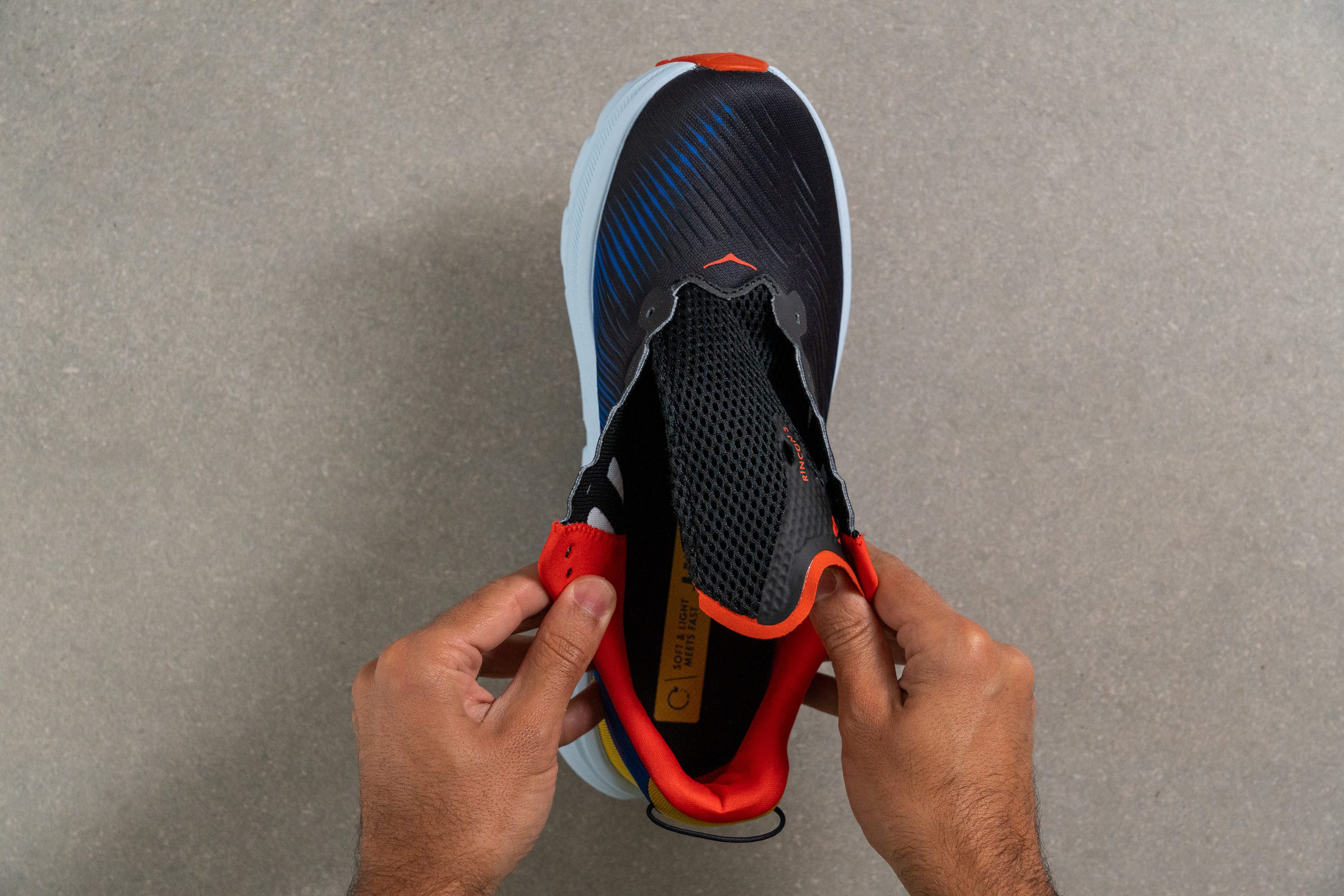
The omission of a gusset is a common weight-saving measure used by manufacturers but, on a daily trainer that’s already lighter than many racing flats, we think the addition of a semi-gusset of sorts would have greatly improved the Rincon 3’s comfort without jeopardizing the shoe’s feathery nature.
| Hoka Rincon 3 | None |
Heel tab
A skinny string forms a roomy and convenient finger loop on the Rincon 3’s heel counter and maintains the shoe’s lightweight yet functional motif. While it seems like it might be quite flimsy, we’re happy to report that we haven’t snapped either of them after taking the shoes on and off plenty of times over the course of testing it.
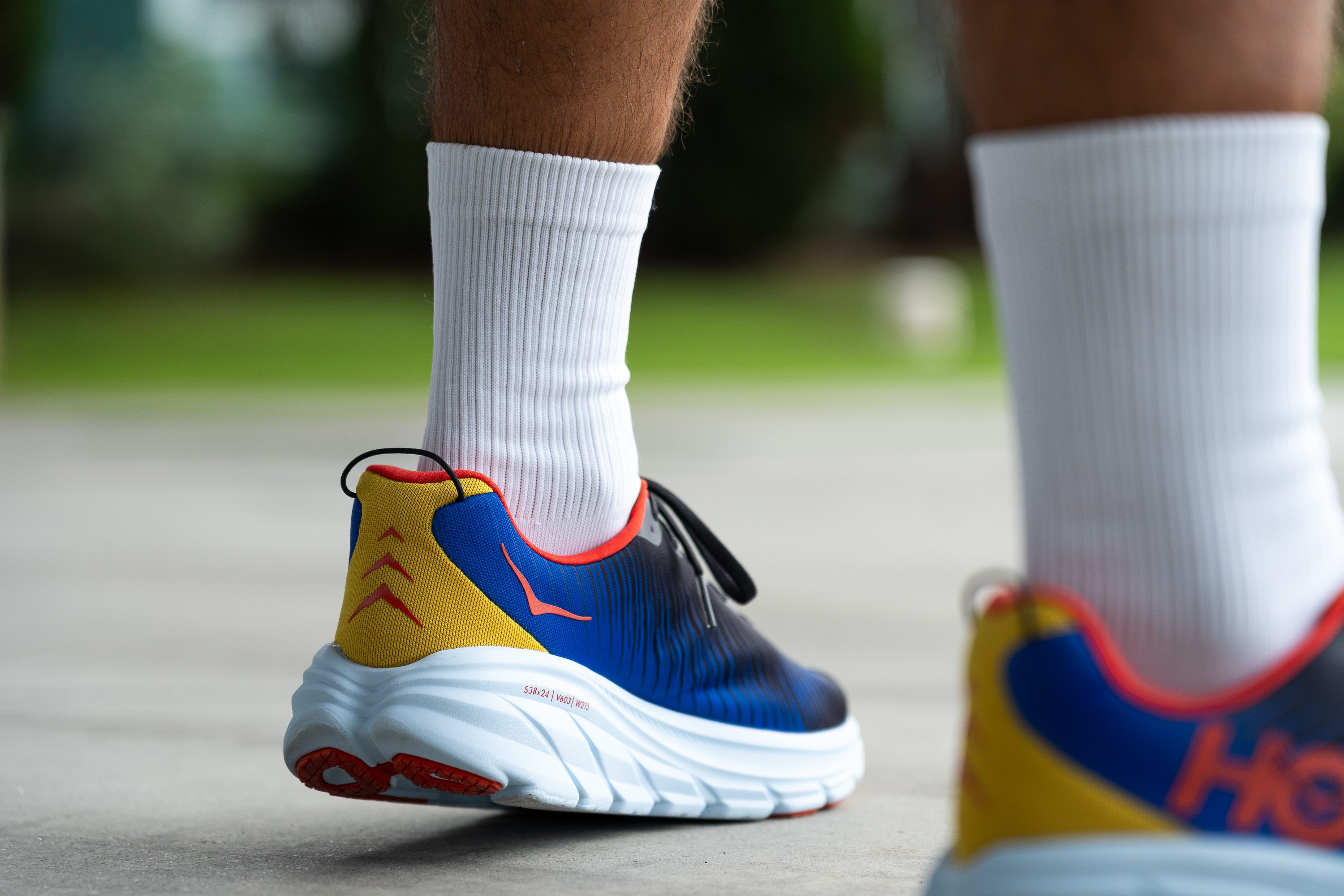
| Hoka Rincon 3 | Finger loop |

